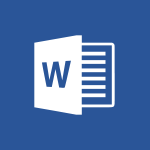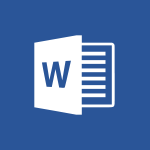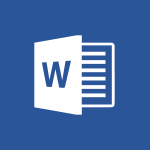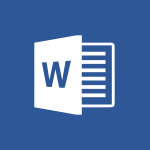Word - Advanced mail merge (Field code) Video
In this video, you will learn about advanced mail merge using field codes.
The video covers how to add a comma to the mileage field in a mail merge by using field codes and switches.
Field codes are placeholders for data that Word adds automatically, and they can be used for things like page numbers and automatic tables of contents.
By using a switch called a picture switch, you can format the numbers in the merge field to include a comma.
This technique goes beyond the basic mail merge commands and allows for more customization.
Understanding and using field codes can enhance your mail merge skills and give you more control over the formatting of your documents.
- 2:59
- 2584 views
-
OneDrive - What is OneDrive ?
- 01:14
- Viewed 1574 times
-
Outlook - Create and modify a group
- 2:19
- Viewed 4351 times
-
OneDrive - Edit, Delete a Share
- 02:16
- Viewed 1036 times
-
Power BI - Introduction to Power Bi
- 1:29
- Viewed 6379 times
-
Teams Premium - Activate the features of Teams Premium
- 3:48
- Viewed 13715 times
-
Teams Premium - Optimize Teams Premium settings in Administration
- 1:27
- Viewed 2605 times
-
Viva Engage - The role of an administrator
- 2:22
- Viewed 4818 times
-
Collapsible headings
- 3:03
- Viewed 6685 times
-
Navigation Pane Part 1 : Rearranging a document
- 2:32
- Viewed 3849 times
-
Copy & Paste
- 3:09
- Viewed 3614 times
-
Introduction to Word
- 0:59
- Viewed 3505 times
-
More things you can do with pictures
- 4:53
- Viewed 3205 times
-
Change footnote font, size, and formatting
- 2:48
- Viewed 3188 times
-
Insert icons
- 0:43
- Viewed 3145 times
-
Locate your documents
- 0:20
- Viewed 3126 times
-
Microsoft Search
- 0:34
- Viewed 3094 times
-
Introduction to Tables of Contents
- 2:57
- Viewed 3084 times
-
More options and custom labels
- 3:59
- Viewed 3062 times
-
Insights into what you're working on
- 0:36
- Viewed 2978 times
-
Use dictate to type in Word
- 0:27
- Viewed 2970 times
-
Faster shape formatting and new and modern chart types
- 1:04
- Viewed 2942 times
-
Mail merge
- 3:51
- Viewed 2934 times
-
Take tables of contents (TOCs) to the next level
- 3:51
- Viewed 2932 times
-
3D Models
- 0:42
- Viewed 2928 times
-
Add a logo or other picture
- 3:17
- Viewed 2912 times
-
Format a document
- 2:58
- Viewed 2895 times
-
Translate Content in Word
- 2:04
- Viewed 2895 times
-
Format and add a graphic
- 3:20
- Viewed 2876 times
-
Save, export and share
- 2:08
- Viewed 2830 times
-
Insert items in a document
- 2:59
- Viewed 2824 times
-
Translate your Word documents into any language
- 0:33
- Viewed 2818 times
-
Let Word read your documents out loud
- 0:36
- Viewed 2813 times
-
Ink Equation
- 0:43
- Viewed 2782 times
-
Edit document with natural gestures
- 0:34
- Viewed 2778 times
-
A first look at Word 2016
- 3:16
- Viewed 2738 times
-
Track changes online
- 3:14
- Viewed 2736 times
-
Print envelopes with mail merge
- 3:58
- Viewed 2734 times
-
Design considerations for orientation
- 2:00
- Viewed 2720 times
-
Add headers, footers, margins, and rulers to a page
- 2:45
- Viewed 2703 times
-
Accessibility in Word
- 2:29
- Viewed 2696 times
-
Insert and customize a footnote
- 3:04
- Viewed 2688 times
-
How things are organized
- 2:00
- Viewed 2676 times
-
Check Accessibility in Word
- 1:42
- Viewed 2657 times
-
Navigation Pane Part 2 : Search Options
- 1:35
- Viewed 2628 times
-
Use landscape and portrait orientation
- 3:28
- Viewed 2620 times
-
Custom margin - Headers and footers
- 1:29
- Viewed 2607 times
-
A closer look at the ribbon
- 3:54
- Viewed 2595 times
-
Track changes in email with multiple people
- 4:36
- Viewed 2593 times
-
Focus on priorities with the Immersive Reader
- 1:13
- Viewed 2590 times
-
Modify a TOC with field codes
- 2:59
- Viewed 2589 times
-
Add multiple TOCs to a document
- 4:59
- Viewed 2554 times
-
Create and print labels
- 3:05
- Viewed 2509 times
-
Chat with co-authors while editing
- 0:29
- Viewed 2501 times
-
Incorporate revisions with track changes
- 3:10
- Viewed 2483 times
-
Pin your important files
- 0:34
- Viewed 2467 times
-
Do things quickly with Tell Me
- 1:04
- Viewed 2425 times
-
Get going fast
- 1:44
- Viewed 2411 times
-
Print letters with mail merge
- 4:02
- Viewed 2403 times
-
Use mail merge to create multiple labels
- 3:21
- Viewed 2392 times
-
Add custom entries to a TOC
- 3:00
- Viewed 2385 times
-
Start working together in a document
- 2:03
- Viewed 2381 times
-
Add formatting to a TOC
- 3:48
- Viewed 2377 times
-
Advanced tables of contents
- 3:15
- Viewed 2346 times
-
Track changes
- 2:34
- Viewed 2346 times
-
Work together in real time
- 1:40
- Viewed 2330 times
-
Customize track changes
- 2:18
- Viewed 2324 times
-
Changing existing styles
- 1:08
- Viewed 2292 times
-
Custom margin - Default margin
- 1:06
- Viewed 2264 times
-
Styles
- 1:49
- Viewed 2261 times
-
Working with watermarks
- 2:48
- Viewed 2145 times
-
Improved version history
- 0:56
- Viewed 2117 times
-
Creating Styles
- 1:03
- Viewed 2110 times
-
Custom margin
- 1:59
- Viewed 2092 times
-
Introducing to Word
- 01:00
- Viewed 165 times
-
Introduction to PowerBI
- 00:60
- Viewed 167 times
-
Introduction to Microsoft Outlook
- 01:09
- Viewed 158 times
-
Introduction to Microsoft Insights
- 02:04
- Viewed 155 times
-
Introduction to Microsoft Viva
- 01:22
- Viewed 161 times
-
Introduction to Planner
- 00:56
- Viewed 169 times
-
Introduction to Microsoft Visio
- 02:07
- Viewed 158 times
-
Introduction to Microsoft Forms
- 00:52
- Viewed 164 times
-
Introducing to Microsoft Designer
- 00:28
- Viewed 224 times
-
Introduction to Sway
- 01:53
- Viewed 142 times
-
Introducing to Word
- 01:00
- Viewed 165 times
-
Introducing to SharePoint Premium
- 00:47
- Viewed 147 times
-
Create a call group
- 01:15
- Viewed 200 times
-
Use call delegation
- 01:07
- Viewed 128 times
-
Assign a delegate for your calls
- 01:08
- Viewed 200 times
-
Ring multiple devices simultaneously
- 01:36
- Viewed 135 times
-
Use the "Do Not Disturb" function for calls
- 01:28
- Viewed 126 times
-
Manage advanced call notifications
- 01:29
- Viewed 141 times
-
Configure audio settings for better sound quality
- 02:08
- Viewed 173 times
-
Block unwanted calls
- 01:24
- Viewed 140 times
-
Disable all call forwarding
- 01:09
- Viewed 141 times
-
Manage a call group in Teams
- 02:01
- Viewed 132 times
-
Update voicemail forwarding settings
- 01:21
- Viewed 130 times
-
Configure call forwarding to internal numbers
- 01:02
- Viewed 123 times
-
Set call forwarding to external numbers
- 01:03
- Viewed 148 times
-
Manage voicemail messages
- 01:55
- Viewed 187 times
-
Access voicemail via mobile and PC
- 02:03
- Viewed 205 times
-
Customize your voicemail greeting
- 02:17
- Viewed 125 times
-
Transfer calls with or without an announcement
- 01:38
- Viewed 121 times
-
Manage simultaneous calls
- 01:52
- Viewed 131 times
-
Support third-party apps during calls
- 01:53
- Viewed 160 times
-
Add participants quickly and securely
- 01:37
- Viewed 132 times
-
Configure call privacy and security settings
- 02:51
- Viewed 130 times
-
Manage calls on hold
- 01:20
- Viewed 136 times
-
Live transcription and generate summaries via AI
- 03:43
- Viewed 126 times
-
Use the interface to make and receive calls
- 01:21
- Viewed 131 times
-
Action Function
- 04:18
- Viewed 138 times
-
Search Function
- 03:42
- Viewed 188 times
-
Date and Time Function
- 02:53
- Viewed 168 times
-
Logical Function
- 03:14
- Viewed 255 times
-
Text Function
- 03:25
- Viewed 199 times
-
Basic Function
- 02:35
- Viewed 158 times
-
Categories of Functions in Power FX
- 01:51
- Viewed 188 times
-
Introduction to Power Fx
- 01:09
- Viewed 159 times
-
The New Calendar
- 03:14
- Viewed 282 times
-
Sections
- 02:34
- Viewed 171 times
-
Customizing Views
- 03:25
- Viewed 165 times
-
Introduction to the New Features of Microsoft Teams
- 00:47
- Viewed 271 times
-
Guide to Using the Microsoft Authenticator App
- 01:47
- Viewed 185 times
-
Turn on Multi-Factor Authentication in the Admin Section
- 02:07
- Viewed 145 times
-
Concept of Multi-Factor Authentication
- 01:51
- Viewed 172 times
-
Retrieve Data from a Web Page and Include it in Excel
- 04:35
- Viewed 391 times
-
Create a Desktop Flow with Power Automate from a Template
- 03:12
- Viewed 333 times
-
Understand the Specifics and Requirements of Desktop Flows
- 02:44
- Viewed 206 times
-
Dropbox: Create a SAS Exchange Between SharePoint and Another Storage Service
- 03:34
- Viewed 348 times
-
Excel: List Files from a Channel in an Excel Workbook with Power Automate
- 04:51
- Viewed 222 times
-
Excel: Link Excel Scripts and Power Automate Flows
- 03:22
- Viewed 228 times
-
SharePoint: Link Microsoft Forms and Lists in a Power Automate Flow
- 04:43
- Viewed 404 times
-
SharePoint: Automate File Movement to an Archive Library
- 05:20
- Viewed 198 times
-
Share Power Automate Flows
- 02:20
- Viewed 193 times
-
Manipulate Dynamic Content with Power FX
- 03:59
- Viewed 196 times
-
Leverage Variables with Power FX in Power Automate
- 03:28
- Viewed 183 times
-
Understand the Concept of Variables and Loops in Power Automate
- 03:55
- Viewed 195 times
-
Add Conditional “Switch” Actions in Power Automate
- 03:58
- Viewed 232 times
-
Add Conditional “IF” Actions in Power Automate
- 03:06
- Viewed 168 times
-
Create an Approval Flow with Power Automate
- 03:10
- Viewed 360 times
-
Create a Scheduled Flow with Power Automate
- 01:29
- Viewed 584 times
-
Create an Instant Flow with Power Automate
- 02:18
- Viewed 337 times
-
Create an Automated Flow with Power Automate
- 03:28
- Viewed 328 times
-
Create a Simple Flow with AI Copilot
- 04:31
- Viewed 305 times
-
Create a Flow Based on a Template with Power Automate
- 03:20
- Viewed 274 times
-
Discover the “Build Space”
- 02:26
- Viewed 192 times
-
The Power Automate Mobile App
- 01:39
- Viewed 200 times
-
Familiarize Yourself with the Different Types of Flows
- 01:37
- Viewed 193 times
-
Understand the Steps to Create a Power Automate Flow
- 01:51
- Viewed 281 times
-
Discover the Power Automate Home Interface
- 02:51
- Viewed 187 times
-
Access Power Automate for the Web
- 01:25
- Viewed 297 times
-
Understand the Benefits of Power Automate
- 01:30
- Viewed 245 times
Objectifs :
This course aims to enhance your understanding of mail merge in Microsoft Word, specifically focusing on the use of field codes to format data, such as adding commas to numerical fields. By the end of this course, you will be able to utilize field codes effectively to customize your mail merge outputs.
Chapitres :
-
Introduction to Mail Merge
Mail merge is a powerful tool in Microsoft Word that allows you to create personalized documents for multiple recipients. If you frequently use mail merge in your business, this course is tailored for you. While the basic functions are straightforward, there are advanced techniques that can enhance your results. -
Understanding Field Codes
Field codes are placeholders in Word that allow for dynamic content generation. They are not limited to mail merge; they also include elements like page numbers and automatic tables of contents. By default, field codes are hidden, but you can toggle their visibility using the keyboard shortcut ALT + F9. -
Using Field Codes for Number Formatting
One common issue with mail merge is the formatting of numerical fields, such as the mileage field, which may not include commas. To address this, you can use field codes to apply specific formatting. The basic field code for mileage is MERGEFIELD Mileage. To add number formatting, you need to include a switch in the field code. -
Applying a Picture Switch
To format the mileage field with commas, you will type a switch directly in the field code. After 'Mileage', press space, then type '\#' followed by a space. In quotation marks, enter '###,###'. This switch tells Word how to format the numbers. After making these changes, press ALT + F9 to view the field code and F9 to update it, revealing the formatted result with commas. -
Exploring Field Code Documentation
For further learning, you can access documentation that details various field codes, their properties, and available switches. This resource provides examples and guidance on how to effectively use field codes in your documents. -
Conclusion
Field codes may not be necessary for everyone, but they are invaluable for those looking to customize their mail merge outputs beyond basic commands. By investing time in understanding and experimenting with field codes, you can significantly enhance the quality of your documents.
FAQ :
What is the purpose of using field codes in mail merge?
Field codes allow users to customize how data is displayed in a mail merge, such as formatting numbers with commas or other specific styles that are not available through standard Word commands.
How do I toggle field codes on and off in Word?
You can toggle field codes on and off by pressing the keyboard shortcut ALT + F9. This will switch between viewing the field codes and their results.
What is a picture switch in Word?
A picture switch is a specific type of switch used in field codes that allows you to define how numbers should be formatted, such as adding commas or other formatting options.
Can I use field codes without any coding knowledge?
While basic use of field codes can be done through Word commands, more advanced formatting and customization may require some research and experimentation with coding techniques.
Where can I find more information about field codes in Word?
You can find detailed information about field codes, including their properties and available switches, in the Microsoft Word documentation or reference links provided within the application.
Quelques cas d'usages :
Customizing Invoice Formats
A business can use field codes in mail merge to customize invoice formats, ensuring that numerical values such as totals and taxes are displayed with commas for better readability.
Creating Personalized Letters
Using mail merge with field codes, a company can create personalized letters that include formatted dates and numbers, enhancing the professionalism of their correspondence.
Generating Reports with Specific Formatting
Field codes can be applied in generating reports where specific number formats are required, such as financial reports that need to display figures with commas for thousands.
Automating Marketing Campaigns
In marketing, field codes can be used to automate the creation of personalized emails that include formatted data, improving engagement and clarity for recipients.
Streamlining Data Entry Processes
Field codes can help streamline data entry processes in organizations by allowing users to format and display data correctly in bulk documents, reducing errors and improving efficiency.
Glossaire :
Mail Merge
A process in Microsoft Word that allows users to create multiple documents at once by combining a template with a data source, such as a list of names and addresses.
Field Code
Placeholders in Word that represent data to be inserted automatically, such as merge fields, page numbers, or tables of contents. They can be toggled on and off using the keyboard shortcut ALT + F9.
Switch
A code added to a field code that modifies its behavior or appearance, such as formatting numbers in a specific way.
Picture Switch
A type of switch that provides a specific format for displaying numbers or other data in Word, using placeholders represented by number signs.
Placeholder
A symbol or text in a document that indicates where specific data will be inserted, such as the number signs in a picture switch.




